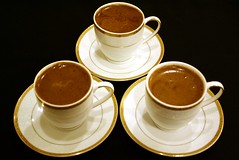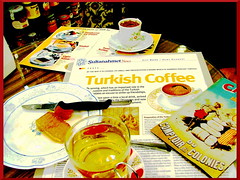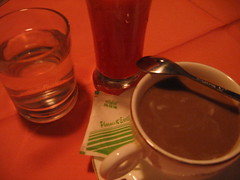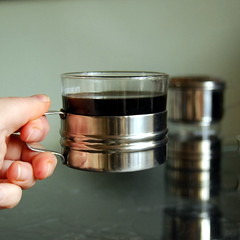by:
Joachim Oster
Premium arabica coffee is a gift from the sun and the earth, born only under perfect environmental conditions in the mountainous regions between the tropics of Capricorn and Cancer. The best coffee requires light, fertile volcanic soil, abundant rainfall, some cloud cover, warm temperatures, very little wind, sunny mornings, rainy afternoons and the purest air. But where on earth can these ideal conditions be found? How about Kona, Hawaii? At the base of volcanoes Mauna Loa and Hualalai, the view is bounded on one side by mountains of perpetual green and pacific blues on the other. The morning air is soft and balmy, yet pure and refreshing. There is no place more beautiful where one would desire to pass their allotted time on earth, nor is there any other place better suited for growing specialty coffee! This is the Kona Coffee Belt, a 20-mile long by 2-mile wide band, which rests 700 to 2,500 feet above sea level. Spanning between the slopes of two volcanoes, lush green hills are covered by small, family owned plantations made up of trees that are sometimes more than a hundred years old. Here's are the 10 key reasons why Kona coffee, one of (if not THE) worlds top gourmet coffees can come only from Kona, Hawaii.
The Air There is an island, which is far away from any other land. So far actually, that when the winds finally arrive, the air is cleaner and clearer than anywhere else on earth. Naturally filtered of pollutants and oxygenated by thousands of miles of ocean in each direction, it feels like breathing pure silk. This is Hawai'i, the most isolated archipelago in the Pacific and in the world. Hawaiian weather patterns are affected primarily by high-pressure zones in the north Pacific that send cool, moist trade winds to the island's northeastern slopes. The winds are forced up-slope, where moisture condenses into rain producing clouds - a phenomenon that creates the rich tropical environment for Hawai'i's flowers and vibrant greens.
The Earth The Big Island is a bit smaller than the state of Connecticut and slightly larger than the island of Cyprus in the Mediterranean Sea. It's the largest of the seven Hawai'ian islands though, yet only 130,000 inhabitants call this place home. Due to Hawai'i's remoteness, the islands have been spared many diseases and countless pests have never landed on its shores, which enables the land, the sea, even the air to remain abundant, fertile and pure. The disintegrating volcanic rock on the Big Island is rich in natural minerals and erodes easily. This geologically young, porous and well-drained soil, mixed with decayed vegetation creates nutritious and healthy pastures for Hawaii's flowers, fruits and verdant greens. The Big Islands broad slopes and high peaks obstruct the flow of weather patterns over the Pacific, causing 13 of the world's 16 global climates to be found here: sunny beaches, tropical rain forests, cool alpine regions and stony deserts - each with its own unique weather, plants and animals.
The Water The year-round warm ocean waters are responsible for the equally balmy air temperature. On their long journey, the trade winds pick up the cleanest ocean water and drop it onto our mountains. Rain is not gloomy here, but nurturing, cleansing, warm and refreshing. Towering cumulus clouds tend to build up over the volcanoes on sunny warm afternoons, resulting in brief, intense and localized showers. One may ask where all the rainwater goes, if not used by vegetation or running back to sea? Accumulated rainwater is filtered through rocks and pools between ancient layers of lava, creating gigantic aquifers of the purest fresh water deep in the earth to be tapped by future generations.
The Fire The Hawaiian islands were created by a fine crack in the mantle of the earth, which leaked so much lava onto the deep ocean floor that it created the world's highest volcano. And if measured from the ocean floor, it is also the world's highest mountain. Magnificent steam explosions occur where the glowing lava flow enters the ocean and creates new land out of rocks, pebbles and sand. The volcano is believed by Hawaiian's to be an incarnation of the goddess Pelé, who is soothed by sacrifices and offerings of respect. Occasionally one may find stony strands of her 'hair' or pellets like shiny 'tears' on the beach, from when she wanders amongst us mortals in the figure of an old woman.
Sun drenched mornings and misty afternoons are not all Kona needs in order to produce the perfect Hawaiian coffee climate. Large steam plumes on the other side of the island are produced where lava enters the ocean. These clouds contain a mixture of light hydrochloric acid and water droplets, which is created when the intense heat of lava evaporates salty seawater. This hazy mixture we call 'laze'. The constant airborne emissions of the Kilauea crater releases sulfur dioxide gases, which react chemically with sunlight and oxygen. They form a sulfuric acid fog we call 'vog' (volcanic fog). The trade winds dilute these cloud mixtures and send them on a hundred mile journey around the southern tip of the island to Kona. Here in the coffee belt this cloud mixtures serve as a gentle and natural fertilizer for the coffee trees. Volcanic soil is sometimes too alkaline and requires these acids in order to balance the pH value, which in turn creates the perfect growing conditions for coffee arabica trees. This unique combination is yet another reason that Kona coffee beans come from the most productive trees on earth!
The Trade Winds Throughout most of the year Hawaiian weather patterns are affected primarily by high-pressure zones in the north Pacific that send cool, moist trade winds to the island's northeastern slopes. The strength of these winds build as the heat of the day rises and reach a peak in the afternoon, only to diminish in the evening and start again the next day. The trade winds are forced up-slope by the mountain heights where moisture condenses into rain producing clouds. Most of this rain falls then in the mountains and valleys on the wet, windward (northeastern) side of the island and it is this weather phenomenon that creates the rich tropical environment for Hawaii's flowers and vibrant greens. Shelter on the dry, leeward (southwestern) side from the prevailing trade winds and occasional tropical storms is provided by the 14,000 foot height of the volcano Mauna Loa. But there is enough wind left for the Kona coffee belt for some cooling breezes during tropical nights.
The Shade of Vector Clouds Coffee trees cannot withstand dryness, heat or frost. For these reasons only the world's premium coffees are grown under shade trees, which protect against the overhead tropical sun. Other commercial or inexpensive coffee varieties require additional fertilizers and pesticides in order to thrive in harsh, sunny terrains. Without a lush tree canopy for protection, the thin tropical soil of these sun-loving varieties is exposed to blazing rays and eroding rains. The sun literally scorches the much-needed microorganisms that exist within the earth. Once destroyed, they must then be replenished artificially. Naturally shade grown Kona coffee maintains a nutrient rich soil, which reduces acidity and produces dense and more flavorful beans. During the course of any given Kona day the land is gently heated by the sun, which draws moist breezes up the slopes to create what's called vector clouds. These clouds not only make shade trees obsolete, but they prompt drizzly convection rains throughout the afternoon. Therefore only in Hawai'i is coffee grown at lower altitudes and naturally irrigated. Each day around 20,000 gallons of pure, fresh Pacific rainwater is poured onto each acre of happy coffee trees. But moments after these periodic rains disappear, one may witness the sun once again pushing its way through at the coast below, creating magnificent rainbows and the most breathtaking Hawaiian sunsets.
The Trees The coffee tree is one of the few plants that can simultaneously grow a blossom as well as a ripe fruit on the same branch. These trees develop a deep root system in our porous, deep and well-drained soil. Not really huge trees, they appear more like bushes with heavily ridged leaves and long whip like branches that bend toward the ground once heavy with fruit. Members of the gardenia family, they produce amazingly fragrant, brilliantly white flowers that coat the hills many times throughout the year. Over here the folks like to call these blooms 'Hawaiian snow'. Century old coffee trees are handpicked to obtain the best flavor, assuring that only the reddest, ripest and finest cherries make it into your cup. Picking cherries too early or too late in the season will affect the taste of coffee, so only a trained eye knows exactly which fruit is at the right stage. Not many people know this, but the average Kona coffee tree yields about 13 pounds of raw cherry, which results in about 2 pounds of roasted coffee. So when you order 2 lbs from a Kona coffee farm, you're actually buying the yearly fruit of an entire tree! If you want to avoid consuming higher levels of caffeine,make sure to always serve coffea arabica beans, as they have half the caffeine, but double the aroma of the cheaper coffea robusta beans. To know that you got any of the other aforementioned benefits buy only pure Hawaiian Kona coffee (100% Kona Coffee).
The Sun Drying During the pulping process the harvested red berries are soaked in the freshest and purest rainwater to ferment overnight. This labor-intense 'wet method' is the preferred way of processing high grown arabicas. The soaked skins and pulp are then removed from the beans, which are later washed and spread out to dry on a wooden dry deck. The moist beans are raked many times throughout the day so that the drying happens uniformly. Kona's warm sun and gentle breezes dry the beans slowly to the perfect moisture level. Commercial grades of coffee utilize a mechanical drying method, which forces hot air over the beans to speed up the drying process. This method proves less labor intensive, therefore lowering the price. Sundried coffee maintains more of a delicate, mellow flavor--whereas kiln dried coffee will oftentimes lose some of the aromas Kona coffee is famous for. The only way to safely preserve coffee and its rich aromas for as long as possible is to keep it in its parchment form. Yet most coffee is processed very quickly to its green bean form in their respective country of origin. Once the green beans are exposed to air, light and humidity, the surface oxidizes and bacteria, yeasts and moulds start their deteriorating work. Many months journeys in the stuffy hold of a ship, various cargo trucks and warehouses go by before the green beans get to the roasters and ultimately to your cup. Better to only hull the parchment of the beans right before they are roasted. It's simply healthier and tastier.
The Small Estates Family owned plantations produce the finest, estate-grown coffee with superior large, dense and flavorful beans. Kona coffee maintains individual subtleties; much better tasting than pooled, generically sold cheaper alternatives. Kona is comparable to the Champagne region in France, which produces the only legitimately named 'Champagne' product. And like Champagne, 100% Kona coffee is distinguished from commercial blends not only by region and the ideal growing conditions, but also by the enormous amount of care taken throughout each step of the farming, harvesting and roasting processes. Whether it's from the individual pruning of the trees, handpicking only the ripest coffee cherries, carefully sun-drying on large open decks and roasting prior to packaging the coffee in specially sealed bags to ensure freshness--you can be assured that Hawaiian Kona coffee is comparable to no other. Only 14,000 to 16,000 sacks of this precious Kona coffee is produced each year by the few hundred farms dotting the hills of this region, making pure Kona coffee the rare and sought after gourmet coffee in the world.
The 100% Rule Most likely any coffees you ever drank came from ultra-productive, low-waged labor, machine-picked and pesticide sprayed coffee farms in other parts of the world. Large companies who trade in coffee are interested in buying the cheapest beans available, resell, ship, store it for many months to the point where they have to infuse coffee aromas back into the beans during the roasting process! And you wonder why your stomach rebels against that second cup... Intense hand labor, only ripe beans, a unique climate and soil in Kona combined with natural processing gives this coffee its greatness. Real, fresh 100% Kona coffee is hard to come by outside of Kona, which is why many coffee drinkers are easily duped. Companies all over the world mislead customers and profit on the reputation of the Kona fame by mixing few Kona coffee beans with much, much cheaper inferior Central or South American beans. This combination produces an atypical, cheaper taste, and is commonly referred to as '10% Kona Blend', 'Kona Roast', or 'Kona Style'. Yet this name misleads folks to believe that the bag of coffee they've purchased contains a mix or 'blend' of various Kona coffees. The law of Hawai'i stipulates that a bag of pure Kona coffee must have printed on its label the words 100% KONA COFFEE to guarantee its contents. So watch out for it and check the bag or cross check the coffee websites carefully before you order!
See many pictures and read more of how a small farm produces delicious, affordable 100% Kona coffee:
http://www.bluehorsekona.com/ (low end pricing)
Life seen through the eyes of a little Hawaiian girl growing up on a genuine small coffee farm in Kona:
http://www.athenaofhawaii.com/ (moderate pricing; celebrity clientele; presented in handcrafted wooden gift boxes and unique tapa cloth pouches)












